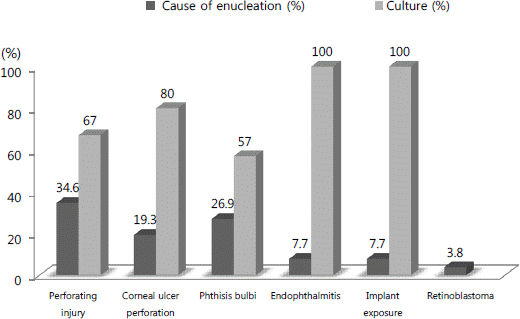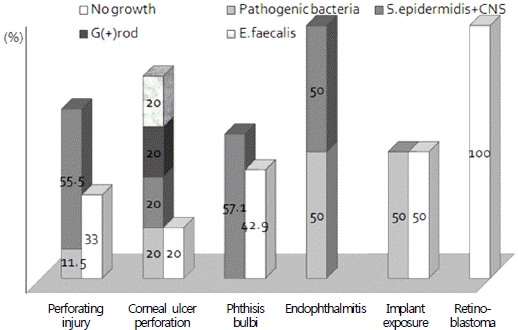Abstract
Purpose
To evaluate the distribution of conjunctival bacterial flora in anophthalmic socket patients with a prosthetic eye, and compare the bacterial positive culture rates between patients with subjective symptoms such as eye wax or irritation and patients without symptoms.
Methods
Twenty-six anophthalmic socket patients with a prosthetic eye who visited our clinic between December 2009 and May 2011 were retrospectively analyzed. The patients were asked about their symptoms, followed by a conjunctiva examination. Specimens were obtained from the inferior conjunctival cul- de- sac with a sterile cotton-tipped applicator. The collected specimens were cultured.
Results
The results indicated that the overall positive culture rate in the anophthalmic conjunctival socket was 69.2%, and the predominant organism was S. epidermidis (38.5%). Potential pathogenic bacteria were found in 4 eyes with a 15% positive culture rate. The incidence of bacteria was significantly higher (85.4%) in patient samples with subjective symptoms compared to patients without symptoms (50%). The bacterial positive culture rate of the potential pathogen bacteria in the group with symptoms was higher at 21%, but was not statistically significant.
Go to : 
References
1. Fahmy JA, Moller S, Bentzon MW. Bacterial flora of the normal conjunctiva. Ⅰ. Topographical distribution. Acta Ophthalmol. 1974; 52:786–800.

2. Srinivasan BD, Jakobiec FA, Iwamoto T, DeVoe AG. Giant papillary conjunctivitis with ocular prostheses. Arch Ophthalmol. 1979; 97:892–5.

3. Goldfarb HJ, Turtz AI. A detergent-lubricant solution for artificial eyes. Am J Ophthalmol. 1966; 61:1502–5.

4. Christensen JN, Fahmy JA. The bacterial flora of the conjunctival anophthalmic socket in glass prosthesis-carriers. Acta Ophthalmol. 1974; 52:801–9.

5. Choi S, Shin D. Comparison of normal bacterial flora in the conjuntival sac of normal and anophthalmic eyes. J Korean Ophthalmol Soc. 1991; 32:939–43.
6. Park HJ, Yi GY, Moon NJ. Bacteriologic study on normal conjunctival flora and change of antibiotic susceptability. J Korean Ophthalmol Soc. 2001; 42:817–24.
7. Chung JH, Chung YJ, Seol SY. Organisms isolated from healthy human conjunctiva and their susceptibility to antimicrobial agents. J Korean Ophthalmol Soc. 1982; 23:305–10.
8. Han HJ, Ahn HS. Culture and antibiotic susceptibility of organisms from healthy and diseased conjunctivae. J Korean Ophthalmol soc. 1983; 24:273–9.
9. Lee KW. Distribution and biological characters of the conjunctival flora. J Korean Ophthalmol Soc. 1985; 26:105–18.
Go to : 
Table 1.
Incidence of the various microorganisms found in the conjunctival sac
| Microorganisms | No. of cases (%) |
|---|---|
| Cogulase negative staphylococcus (CNS)* | 1 (3.8) |
| S. aureus | 1 (3.8) |
| S. epidermidis | 10 (38.7) |
| Streptococcus spp. | 1 (3.8) |
| Enterococcus faecalis | 1 (3.8) |
| Gram-positive bacilli | 2 (7.6) |
| Gram-negative bacilli | 2 (7.6) |
| Potential pathogenic bacteria† | 4 (22.8) |
| No growth | 8 (30.8) |
| Total | 26 |
Table 2.
Correlation between bacterial positive culture rate and symptoms
| Microorganisms | Symptoms (%) | No symptoms (%) | Total | Paired t-test |
|---|---|---|---|---|
| Growth | 12 (85.7%) | 6 (50%) | 18 |
p < 0.05
p = 0.049
|
| Cogulase negative staphylococcus* | 1 (7.1%) | 0 | 1 | |
| S. aureus | 1 (7.1%) | 0 | 1 | |
| S. epidermidis | 5 (35.7%) | 5 (41.7%) | 10 | |
| Streptococcus spp. | 0 | 1 (8.3%) | 1 | |
| Enterococcus faecalis | 1 (7.1%) | 0 | 1 | |
| Gram-positive bacilli | 2 (14.2%) | 0 | 2 | |
| Gram-negative bacilli | 2 (14.2%) | 0 | 2 | |
| Potential pathogenic bacteria* | 3 (21.4%) | 1 (8.3%) | 4 | n.s.* p = 0.356 |
| No growth | 2 (14.2%) | 6 (50%) | 8 | |
| Total | 14 | 12 | 26 (100%) |
Table 3.
Antimicrobial sensitivity patterns of microorganisms isolated from anophthalmic conjunctival sac




 PDF
PDF ePub
ePub Citation
Citation Print
Print




 XML Download
XML Download